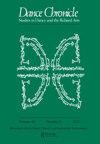东亚舞蹈的去中心化与中心化:跨国舞蹈研究中的语言与区位
IF 0.1
3区 艺术学
0 DANCE
引用次数: 0
摘要
《语料库政治:东亚舞蹈》是“第一本英文长篇出版物”(第2页),介绍了东亚舞蹈的学术研究。这本选集由16章组成,包括一个引言和一个结尾,出现在东亚舞蹈研究的不断发展的领域,这是英语学术界以前代表性不足的领域。编辑们解释了在美国机构内举行并得到其支持的一系列工作组、会议、研究项目、圆桌会议和小组讨论如何将参与者的不同研究兴趣综合成一个有重点的讨论。《主体政治学》既借鉴了东亚批判领域的研究成果,又借鉴了东亚批判性舞蹈的研究成果。作为一名在美国学习、目前在韩国工作的舞蹈研究人员,我看到这本选集——以及我的评论——随着英国曲调跳舞。关于“东亚”所包含的地理范围,本书主要涵盖了中国、香港、台湾、日本以及南北韩。Emily Wilcox的《导论》挑战了东亚舞蹈在国家边界范围内的概念,这是由以国家为中心的项目和资金生态所设计的(第7页)。因此,大约一半的章节明确阐述了国际影响和入侵,强调了该地区的建筑性质。然而,另一半章节提供了一个国家内部的研究,准确地强调了在舞蹈分析中不能忽视这个国家,因为艺术和文化是一个严重依赖国家支持的“补贴市场”。考虑到舞蹈是由国家政策塑造的,甚至在国家宣传中发挥着作用,我阅读了关注单一国家背景的章节,以反映国家如何在全球范围内对舞蹈产生重大影响。就时间跨度而言,这本书涵盖了从古代到当今数字技术的舞蹈,更详细地关注了20世纪,世界大战、帝国主义和本文章由计算机程序翻译,如有差异,请以英文原文为准。
Decentering and Centering East Asian Dance: Language and Location in Transnational Dance Research
Corporeal Politics: Dancing East Asia is “the first book-length publication in English” (p. 2) presenting academic research on East Asian dance. Composed of sixteen chapters contained by an introduction and a coda, this anthology emerges from the growing field of East Asian dance research, a previously underrepresented area in Anglophone academia. The editors explain how a series of working groups, conferences, research programs, roundtables, and panels held in and supported by US-based institutions has synthesized the participants’ diverse research interests into a focused discourse. Drawing both from critical area studies (East Asia) and critical dance studies, Corporeal Politics stresses the politics of East Asian dance. As a dance researcher who studied in the US and currently works in Korea, I see this anthology—and my review—dancing to the English tune. With reference to the geographical range included within the term “East Asia,” this book mainly covers China, Hong Kong, Taiwan, Japan, and North and South Korea. Emily Wilcox’s “Introduction” challenges the conception of East Asian dance within the confines of national borders as engineered by an ecology of nation-centered projects and funding (p. 7). Accordingly, about half of the chapters explicitly address international influences and intrusions, highlighting the area’s constructed nature. However, the other half of the chapters provide studies within a single nation, accurately highlighting that the nation cannot be ignored in dance analysis, as arts and culture is a “subsidized market” that relies heavily on national support. Considering that dance has been shaped by state policy and even plays a role in national propaganda, I read the chapters focusing on a singular national context as a reflection of how, globally, the state greatly influences dance. In terms of temporal span, the book covers dance from ancient times up to the digital technologies of the present day with a more elaborated focus on the twentieth century, accentuated by the world wars, imperialism, and
求助全文
通过发布文献求助,成功后即可免费获取论文全文。
去求助
来源期刊

DANCE CHRONICLE
DANCE-
CiteScore
0.40
自引率
0.00%
发文量
22
期刊介绍:
For dance scholars, professors, practitioners, and aficionados, Dance Chronicle is indispensable for keeping up with the rapidly changing field of dance studies. Dance Chronicle publishes research on a wide variety of Western and non-Western forms, including classical, avant-garde, and popular genres, often in connection with the related arts: music, literature, visual arts, theatre, and film. Our purview encompasses research rooted in humanities-based paradigms: historical, theoretical, aesthetic, ethnographic, and multi-modal inquiries into dance as art and/or cultural practice. Offering the best from both established and emerging dance scholars, Dance Chronicle is an ideal resource for those who love dance, past and present. Recently, Dance Chronicle has featured special issues on visual arts and dance, literature and dance, music and dance, dance criticism, preserving dance as a living legacy, dancing identity in diaspora, choreographers at the cutting edge, Martha Graham, women choreographers in ballet, and ballet in a global world.
 求助内容:
求助内容: 应助结果提醒方式:
应助结果提醒方式:


